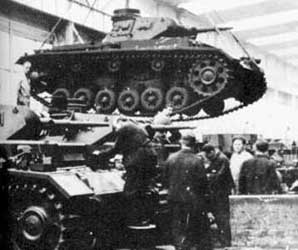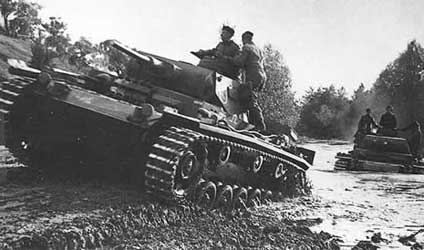/Vehicles/Axis/Germany/02-mPanzers/PzKpfw3/File/1-Genesis-Production.htm | Up-dated:
Panzerkampfwagen III Medium Tank
Genesis
Les chars légers Pz.Kpfw I et Pz.Kpfw II permirent à l'industrie de guerre allemande de se faire la main. Elle ne devait plus désormais dépendre des réalisations étrangères. L'officier d'état-major spécialiste des blindés, le Général Guderian, préconisait la réalisation de 2 types de chars de bataille afin d'équiper les futures Panzerdivisionen. Selon lui, le premier modèle devait être armé d'un canon tirant des munitions perforantes, une mitrailleuse de caisse et une mitrailleuse de tourelle. Le deuxième modèle, considéré comme un engin d'appui devait être armé d'un canon de plus gros calibre à faible vitesse initiale. Le premier de ces deux engins, le Pz.Kpfw III devait en théorie équiper les trois escadrons légers des Panzerregiments.
L'armement du Panzer III, divisa sensiblement les hautes sphères, le Ministère de l'armement appuyant le canon de 37mm tandis que l'Inspection des troupes motorisées soutenait le canon de 50mm. Comme l'infanterie était en grande partie équipée du canon de 37mm, dans un but de standardisation, ce fut ce canon qui fut choisi. Cependant la circulaire de la tourelle devait pouvoir permettre ultérieurement l'installation d'un plus gros calibre.
The light tanks Pz.Kpfw I and Pz.Kpfw II made it possible the German industry of war to got a good experience. It was not from now on to depend any more on the foreign achievements. The staff officer specialist in the armoured tanks, the General Guderian, recommended the realization of 2 types of battle tanks in order to equip future Panzerdivisionen. According to him, the first model was to be armed with a gun firing piercing ammo, a bow machine-gun and a machine-gun on turret. The second model, considered as a support vehicle was to be armed with a gun of larger caliber with low initial speed. The first of these two machines, Pz.Kpfw III was in theory to equip the three light squadrons in Panzerregiments.
The armament of Panzer III, divided appreciably the higher leaders, the Ministry for the armament supporting the gun of 37mm while the Inspection of the motorized troops supported the gun of 50mm. As the infantry was mainly equipped with the gun of 37mm, in an aim of standardization, it was this gun which was selected. However the circular of the turret was to be able to allow later on the installation of a larger caliber.
 |
Krupp
MKA |
src: Site "Achtung
Panzer" |
En raison des limitations de circulation sur les routes et les ponts, le poids de combat maximum fut fixé à 24 tonnes pour le Panzer III et le Panzer IV. Une vitesse maximale sur route de 40 km/h fut requise. L'équipage de 5 hommes était composé comme tel: un chef de char, un pilote, un radio-mitrailleur, un tireur et un chargeur. Des laryngophones devaient permettre les communications intérieures entre chars au cours de la progression.
En 1935, le Service de l'armement de l'armée de terre (Heereswaffenamt) sollicita les firmes MAN, Daimler-Benz, Rheinmetall-Borsig et Krupp pour la mise au point du Panzer III sous le nom de couverture de Zugkraftwagen (tracteur). Dès 1936, des prototypes furent soumis à des essais poussés. C'est en définitive le modèle de Daimler-Benz qui sera choisi. Le premier char sera fabriqué par Daimler-Benz, la même année. Ce modèle sera testé lors d'essais de corps de troupe sous la désignation 1/ZW. La suspension du 1/ZW était de type expérimental à cinq grands supports de galets doubles munis de ressorts hélicoïdaux. Cet engin d'environ 15 tonnes possédait un blindage maximum de 14,5mm et était propulsé par un 12 cylindres Maybach DSO 108TR à haute performance (11 l de cylindrée) fournissant une puissance de 250CV et une vitesse de pointe de 32km/h. Ce char emportait 150 coups de 37mm et 4500 cartouches pour ses trois mitrailleuses, dont deux étaient montées coaxialement avec la canon dans la tourelle. Ce premier modèle reçu l'appellation officieuse de Pz.Kpfw III Ausf.A.
Because of the limitations of circulation on the roads and the bridges, the maximum weight of combat was fixed at 24 tons for Panzer III and Panzer IV. A maximum speed on road of 40 km/h was necessary. The crew of 5 men was composed like such: a commander, a pilot, a radio-machine gunner, a gunner and a loader. Throat microphones were to allow the interior communications between tanks during the progression.
In 1935, the Service of the armament of the Army (Heereswaffenamt) solicited the firms MAN, Daimler-Benz, Rheinmetall-Borsig and Krupp for the development of Panzer III under the cover name of Zugkraftwagen (tractor). Since 1936, prototypes were subjected to thorough tests. It is ultimately the model of Daimler-Benz which will be selected. The first tank will be manufactured by Daimler-Benz, the same year. This model will be tested during tests of corps of troop under designation 1/ZW. The suspension of the 1/ZW was a experimental type with five great supports of double road wheels with helical springs. This machine of approximately 15 tons had a maximum shielding of 14.5mm and was propelled by one 12 cylinders Maybach DSO 108TR to high performance (11 L of displacement) providing a power of 250HP and a maximum speed of 32km/h. This tank carried 150 rounds of 37mm and 4500 rounds for its three machine-guns, which two were coaxialy assembled with the gun in the turret. This first model received the semi-official name of Pz.Kpfw III Ausf.A.
Production
A l'origine aucune fabrication en masse de ce char n'avait été prévue. En effet peu d'adjudicataires avaient une grande expérience de la production de véhicules en série. Les deux sociétés géantes de fabrication automobile Ford et Opel avaient été mises à l'écart de la production de char, en raison de leur appartenance américaine. C'est pourquoi seul Daimler-Benz au début fut chargé de produire le Panzer III (à partir de 1937).
Il faut comprendre, que les premiers modèles (A-E) ne furent que des modèles de présérie produits en faible nombre (voir tableau) et que la production en masse ne débuta véritablement qu'avec le modèle F fin 1939. En effet à cette époque il était déjà évident que les Panzers I et II étaient complètement obsolète et insuffisant pour faire face au chars français et anglais. C'est pourquoi la production du Panzer III fut dopée en mettant de nouvelles firmes sur le coup: Henschel, MAN, Alkett FAMO... puis Wegmann, MNH, MIAG en raison de l'urgence d'un char de combat valable.
At the origin no mass production of this tank had been envisaged. Indeed few contractors had great experience of the production of standard vehicles. The two giant companies of automobile manufacture Ford and Opel had been put out of the production of tank, because of their American membership. This is why only Daimler-Benz at the beginning was charged to produce Panzer III (since 1937).
It should be understood, that the first models (A-E) were only models of preproduction produced in low number (see table) and that the mass production began truly only with the model F at the end of 1939. Indeed at that time it was already obvious that Panzers I and II were completely obsolete and insufficient to face the French and English tanks. This is why the production of Panzer III was doped by putting new firms on the work: Henschel, MAN, Alkett FAMO... then Wegmann, MNH, MIAG because of the urgency of a valid tank.
 |
Panzer III Ausf.E/F assembly line |
src: Site "Juggernauts
of the second world war" |
Cependant, le canon de 37mm s'avéra vite être insuffisant et sera remplacé par le canon de 50mm. Malgré ce canon, le Panzer III ne put jamais prétendre au titre de roi des champs de bataille, dépassé irrémédiablement par la majorité des designs alliés. La production connaîtra son maximum en 1941-1942 avec environ 4000 exemplaires produits mais son remplacement petit à petit par le Panzer IV sonna le glas de la production du Panzer III vers la mi-1943 avec un total de 5728 exemplaires.
However, the gun of 37mm quickly proved to be insufficient and will be replaced by the gun of 50mm. In spite of this gun, Panzer III could not never claim to the title of king of the battle fields, exceeded irremediably by the majority of the allied designs. The production will know its maximum in 1941-1942 with approximately 4000 produced specimens but its replacement gradually by Panzer IV rang the knell of the production of Panzer III towards the mid 1943 with a total of 5728 specimens.
 |
Panzer III Ausf.J sur le front
est |
Panzer III
Ausf.J on the Eastern front |
src: Site "German's
Vehicle History" |
| Ausf | Manufacturers | Date |
# |
| A | Daimler-Benz | 1937 |
10 |
| B | Daimler-Benz | 1937 |
15 |
| C | Daimler-Benz | 1937-1/1938 |
15 |
| D | Daimler-Benz | 1/38-6/38 |
30 |
| E | Daimler-Benz, Henschel, MAN | 12/38-10/39 |
96 |
| F | Daimler-Benz, Henschel, MAN, Alkett, FAMO | 9/39-7/40 |
435 |
| G | Daimler-Benz, MAN, Alkett, Henschel, Wegmann, FAMO, MNH | 4/40-2/41 |
600 |
| H | MAN, Alkett, Henschzl, Wegmann, MNH, MIAG | 10/40-4/41 |
308 |
| J | Daimler-Benz, MAN, Alkett, Henschel | 3/41-7/42 |
1549 |
| J/1 | Daimler-Benz, Alkett, Henschel, Wegmann, MNH, MIAG, MAN | 12/41-7/42 |
1067 |
| L | Henschel, Wegmann, Alkett, MNH, MIAG, MAN, Daimler-Benz | 6/42-12/42 |
653 |
| M | Wegmann, MAN, MIAG, MNH | 10/42-2/43 |
250 |
| N | Henschel, Wegmann, MNH, MIAG, MAN | 6/42-8/43 |
700 |
| TOTAL |
5728 |
Sources:
- Pz.Kpfw III in action, Armor Number 24 (squadron/signal publications, inc.)
- Connaissance de l'Histoire (Hachette) - N°17 - " Les chars de combat allemands 39-45"
- Connaissance de l'Histoire (Hachette) - N°5 - " Véhicules blindés allemands 39-45"
- Les Blindés de la Seconde Guerre Mondiale (Atlas)
- Panzerkampfwagen III Medium Tank 1936-1944 (Osprey Military) - New Vanguard N°27
- Site "Achtung Panzer" - http://www.achtungpanzer.com
- Site "Germany's vehicle history" - http://www.wwiivehicles.com
- Site "Second World War Armour" - http://www.onwar.com/tanks/index.htm